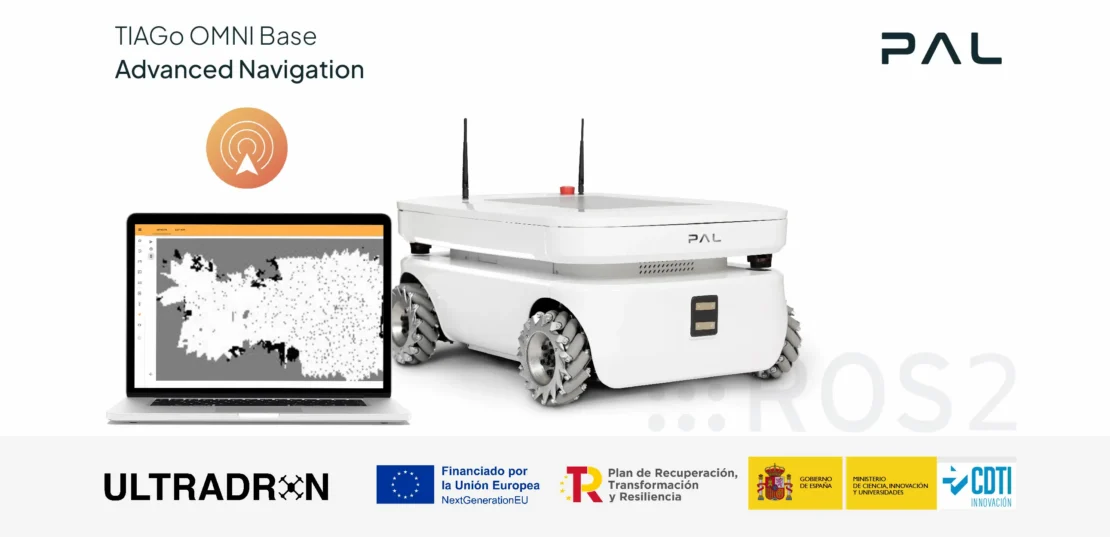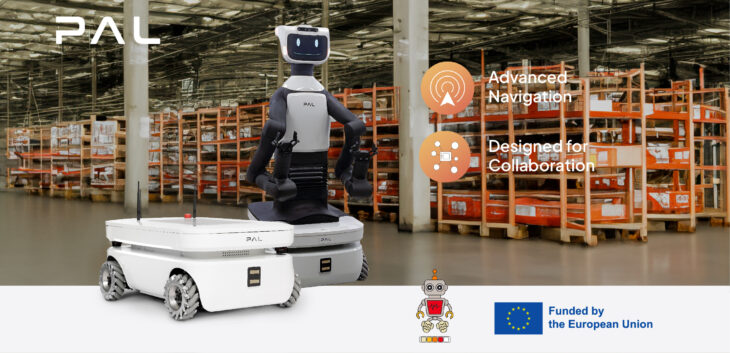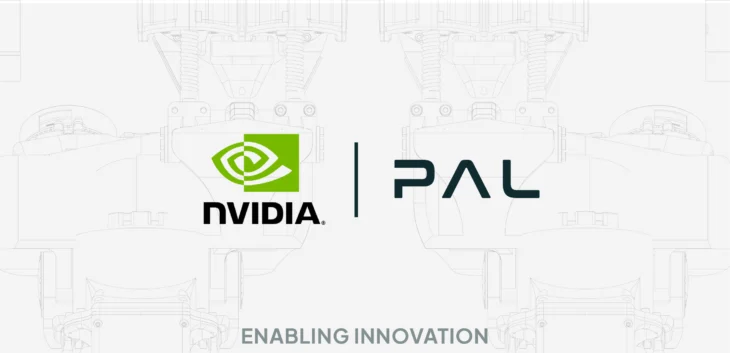
The logistics industry is on the brink of a radical transformation, driven by the demand for faster, more efficient, and fully autonomous operations. At the heart of this shift lies the ULTRADRON project, an ambitious initiative to create an intelligent drone-based transport unit, seamlessly integrated with a portable logistics vertiport (VLP).
The future of autonomous logistics
This visionary concept goes beyond simple point-to-point drone deliveries. It imagines a complete logistics ecosystem where aerial and ground operations are perfectly synchronized and fully automated.
Within this ecosystem, the Autonomous Mobile Robot (AMR) developed by PAL Robotics plays a critical role, acting as both the “brain and muscle” of ground operations. Its mission is not merely to carry packages, but to serve as the essential link ensuring flow, precision, and autonomy throughout the VLP. For this vision to succeed, the AMR must navigate with unprecedented reliability and accuracy in dynamic, complex environments. Navigation, therefore, is not just a technical upgrade, it is the foundational technology upon which the entire ULTRADRON concept depends.
More than just a vehicle
The full title of the project; “Enabling Technologies for an Intelligent Drone-Based Logistics Unit”, highlights the integrated nature of the system. It’s not about isolated machines, but about orchestrating air and ground technologies into a single, cohesive network.
As documented by project partners such as TECNALIA, the interaction between the AMR and the VLP demonstrates that navigation challenges extend far beyond simple movement. They involve complex, mission-critical tasks within an operations hub, elevating navigation from a feature to the very backbone of ground logistics.
A foundational leap: embracing ROS 2 and NAV2
To meet these demanding requirements, PAL Robotics has made a strategic decision: migrating its entire navigation stack from the well-established, but now outdated, ROS 1 (Robot Operating System) to the modern, industrial-grade ROS 2.
This move marks a generational leap, a transition from a research-oriented platform to a robust, production-ready foundation. Unlike ROS 1, which relied on a centralized master node (a single point of failure), ROS 2 is decentralized, allowing nodes to communicate directly. This shift eliminates systemic vulnerabilities and ensures far greater reliability.
Crucially, ROS 2 is built on the Data Distribution Service (DDS), an industry standard used in mission-critical sectors like aerospace and defense. DDS enables real-time, secure, and resilient communication, even in unstable networks, an essential capability for high-stakes logistics operations.
Building on NAV2: The Industry’s Navigation Standard
On top of ROS 2, PAL Robotics has implemented NAV2, the official successor to the original ROS navigation stack and today’s de facto industry standard. NAV2 is not a single tool but an ecosystem of modular, high-performance components, including path planning, motion control, costmap management, and fault-recovery behaviors.
Adopting NAV2 places PAL Robotics at the forefront of autonomous navigation, aligning with a global community of developers and companies deploying this technology at scale.
This shift is more than technical fine-tuning, it directly addresses business risks. The ULTRADRON technical report points out the weaknesses of ROS 1 systems: hard to maintain, lacking standard APIs, costly to develop, and less reliable. By migrating to ROS 2 and NAV2, PAL Robotics not only solves these challenges but also future-proofs its navigation stack. Customers benefit from a maintainable, globally supported, and industry-aligned solution, rather than depending on fragile, proprietary software.
Ready for Real-World Challenges
PAL Robotics’ navigation breakthroughs for ULTRADRON represent much more than a software upgrade. They redefine robotic autonomy in complex logistics environments.
The strategic leap to ROS 2 and NAV2 provides a robust, production-grade foundation. Building on this, PAL Robotics has introduced innovations such as a smart docking system that integrates obstacle avoidance at all times, centralized map management fully compatible with OpenRMF, and adaptive motion controllers like RPP and MPPI. Together, these elements equip the AMR with the intelligence, safety, and scalability needed to perform gracefully and efficiently in the most unpredictable logistics environments.
By combining these elements, PAL Robotics positions itself, and the ULTRADRON project, as a trailblazer in the future of autonomous logistics, setting the stage for a new era where ground and aerial robotics work together seamlessly.


